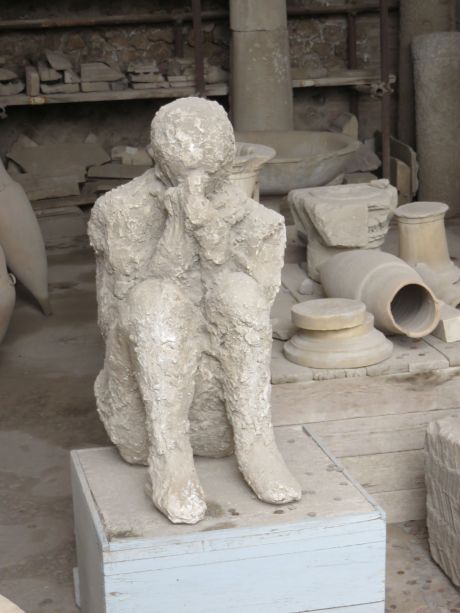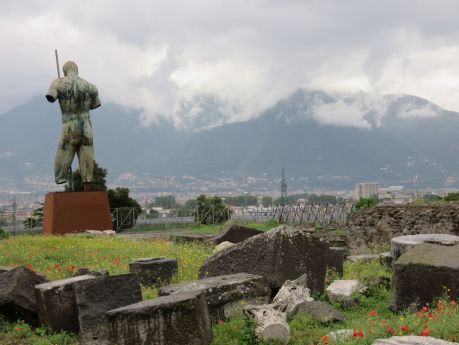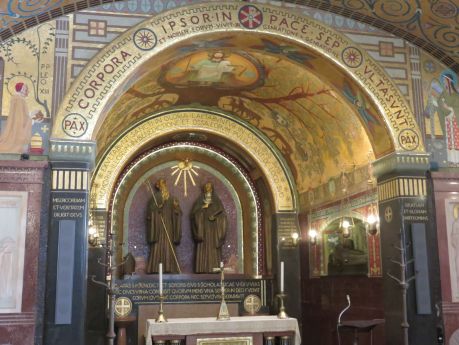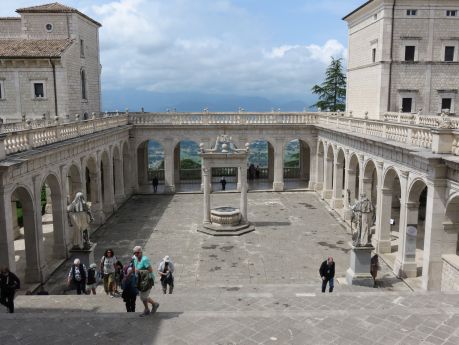Part 2: GONDALIERS DON’T SING AND NO ITALIAN WEDDING SOUP? A FIRST-TIMER’S DISCOVERY OF THE REAL ITALY.
SEX, LIVES AND JEWELRY OF POMPEII AND SORRENTO
Part 1 was The Magnificent Sights And Sounds Of Amalfi And Ravello
POMPEII, SORRENTO and MONTECASSINO
Watching one of many fictionalized movies about the destruction of Pompeii and Herculaneum in 79 AD when Mount Vesuvius erupted does not adequately impart the swift horror that befall the populace. Vesuvius has since erupted nearly 30 more times, the last being March 17, 1944. Considered one of the most dangerously active volcanos in the world, it’s scary to know it sits only about 20 miles from the city of Naples. Estimates are that as many as 30,000 residents may have been “frozen in place” under ash in 79 AD. An eruption today might cause as many as
600,000 people to be evacuated, according to the local guide.
According to.Britannica.com, the ruins of Pompeii were discovered late in the 16th century and Herculaneum in 1709. Excavations began in 1748 in Pompeii, 10 years after Herculaneum. “The work at these towns in the mid-18th century marked the start of the modern science of archaeology,” according to Brittanica.com. Excavations continue today.
What we saw:
Our guided tour through Pompeii was enlightening. The city was lightyears ahead in terms of cobbled streets and water systems. You can tell the difference in ruins from where a house stood vs a business. Houses had ruts near the street, indicating doors that were slid into place. We saw the ruins of mansions, including one where the patterned tile entranceway is nearly intact.
I had no idea of the obsession of brothels. There were more than 200 of them. Etched penises into the stone streets point the way to the nearest brothel. The start of advertisement? We saw stone beds with built-in stone pillows where the prostitutes plied their trade.
There is a section now used to store excavated sculptures, tools and other materials that speaks of daily life, but eerily fascinating are the glass boxes containing the preserved bones of people frozen in position. We were told that the majority of “frozen animals and bodies” now repose in a museum in Naples.
A couple words of advice: Pompeii is open to the elements. We were fortunate to have a cloudy day. Rain or a hot sunny day can make for a very different experience. Be prepared. Also, the ground surfaces are uneven stone tiles or rutted grooves. In rain, quite slippery. Sandals may not be the best option.
Sorrento is a city that we all wished we could have stayed in longer. At least those among us who were drawn by the throngs of people inching along congested streets of boutique and small restaurants. The city is known for coral jewelry and cameos carved from shells. Not the onyx cameos of nameless female faces with which I’m familiar, but individually-carved designs from shells that reveal layers of colors. We were treated to a demo at Bimonte, a small family-owned shop producing high quality art pieces. One of the aspects that separates this company’s cameos from the competition is that theirs have gold or silver backing designs, beautiful unto themselves. Each piece is signed.
The road from Pompeii back to our hotel in Marmorata is a 31-mile stretch traversing the Amalfi coastline. A low barrel-shaped concrete wall and careful drivers are all that separate you from going over the mountain edge. Terraced layers of netting-covered fruit trees and grapevines line the other side.
One reason to take a tour rather than drive yourself is being able to see the scenery instead of wondering whether the drivers coming at you know the curves well. Also, some of the lanes of traffic seem incapable of supporting two-way traffic, so all you can do as a passenger is hold your breath as you each squeeze past. Rules of the road for a bus driver are to honk before entering each curve.
We stopped for a light lunch on the way to Rome at an AutoGrille. Think stops along an American turnpike, except this was one restaurant with diverse food offerings and pretty much anything else you would buy at a variety store. We happened to buy a half-bottle of 2016 Col Di Sasso Toscana, Sangiovese and cabernet sauvignon blend to enjoy. Not bad. Better than the food.
En route to Rome, we stopped in Montecassino to tour the famous Abbey, mother church of the Benedictine order and center of medieval art. St. Benedict originally established the order in the 6th century as a sanctuary for those seeking a true spiritual life. He is considered the Father of Western Monastic Life. The Abbey was bombed heavily in February, 1944 during WWII in the Battle of Montecassino, sometimes referred to the Battle for Rome because Germans were using it as a stronghold. Many of the Abbey’s artifacts, library archives and documents, and numerous other priceless treasures were moved for safe-keeping to Vatican City, yet the Abbey belongs to Italy, not to the Vatican. For the fourth time, it was destroyed. Montecassino now resembles the original Abbey, with many elements, such as a tiled floor originally laid in the 11th century, still in place.
Up to the start of WWII, about 300 Benedictine monks lived and worked there. They survived by hiding downstairs in the crypt. An iron gate that looks like the twisted branches of trees leads to the oldest part of the Abbey where survivors huddled. Remnants of art, tile and masonry from the bombing artistically line sandstone-colored marble staircase walls up to the high arched ceiling. An 11th century bronze door leading to the main church survived both an earthquake and the bombing.
Scriptures imprinted on the doors list properties of the Abby back in the 11th century. The underground crypt is part original and partially reconstructed. Colorful frescos of inlaid wooden crests line arched walls. The ceiling looks like metallic gold inlaid with turquoise flowers. Sculptures of monks don the walls.
The final reconstruction of the Montecassino Abbey began in 1949 and was again consecrated in 1964 by Pope Paul VI. The valuables stored at the Vatican during the war were all returned. Today there are maybe 10 monks still living and working in this high mountain sanctuary. Each Sunday at 10:30 they hold a solemn mass with organ concert and Gregorian chants that’s open to the public.
Next in Part 3 – THE POWER OF PRAYER AND GOVERNMENTS RULED ROME
www.bimontesorrento.com
www.abbaziamontecassino.org/abbey
Karen Kuzsel is a writer-editor based in the Orlando area who specializes in the hospitality, entertainment, meetings & events industries. She is an active member of ILEA and MPI and is now serving on the 2017 – 2018 MPI Global Advisory Board for The Meeting Professional Magazine for the third consecutive year. She is a member of the Society of Professional Journalists. Karen writes about food & wine, spas, destinations, venues, meetings & events. A career journalist, she has owned magazines, written for newspapers, trade publications, radio and TV. As her alter-ego, Natasha, The Psychic Lady, she is a featured entertainer for corporate and social events. karenkuzsel@earthlink.net; www.ThePsychicLady.com; @karenkuzsel; @thepsychiclady.
Photos by Russ Wagner, a retired government planner/builder who has a passion for trains, travel and taking photographs.










Thank you, Karen.